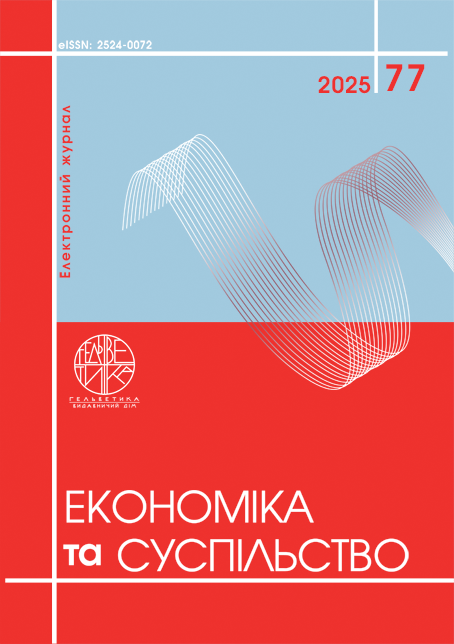ARTIFICIAL INTELLIGENCE AS A TOOL FOR DEVELOPING INNOVATION IN MECHANICAL ENGINEERING
Abstract
The article examines Artificial Intelligence (AI) as a strategic tool for innovative development of the Ukrainian machine-building sector under wartime challenges and post-war recovery. Machine building, once the backbone of national industry, faced severe losses in 2022–2023: its share dropped to 7–8%, exports fell by over 35%, production facilities reached critical depreciation, and skilled personnel outflow increased. Integration of AI is viewed as a modernization factor that can enhance efficiency and competitiveness. The paper reviews global experience (Germany, USA, Japan, China), showing that AI raises productivity by 20–30%, reduces downtime by up to 50%, and lowers defects by 25–30%. Based on these outcomes, promising directions for Ukraine include predictive maintenance, energy and process optimization, automated quality control via computer vision, digitalized supply chains, cybersecurity, generative design, and green engineering. An economic model to assess AI impact combines profit growth and cost reduction. It was tested on Pozhmashina, Tital, MAN Ukraine, AutoKrAZ, and Validus, specializing in fire-fighting and special-purpose vehicles. Results show annual economic effect of 49–75 million UAH, with ROI of 30–45.3%. Forecasting suggests productivity growth of 37–52% within three years after AI adoption. Findings confirm that AI acts not only as a process optimization tool but also as a strategic driver for Ukraine’s recovery. Intelligent systems strengthen resilience of machine building, expand export potential, and facilitate integration into global value chains. The study stresses the need for a state-level digitalization strategy, stronger public–private partnerships, business–academia collaboration, and investments in AI-driven innovation. These results provide a foundation for shaping economic policy and practical solutions in digital transformation of industry.
References
Porter, M. E. (1980). Competitive strategy: Techniques for analyzing industries and competitors. New York: Free Press, pp. 311-312.
OECD. (2019). Artificial intelligence in society. Paris: OECD Publishing, pp.109-111.
World Bank. (2021). Digital transformation of the manufacturing sector. Washington, DC: World Bank, pp.41-42.
Суботін О. О., Новіков Д. В. Застосування штучного інтелекту для автоматизації роботизованих процесів. Молодий вчений. 2025. № 2(133). С. 85–90. URL: https://molodyivchenyi.ua/index.php/journal/article/view/6379 (дата звернення: 30.08.2025).
Красношапка Н., Малієнко С., Гуда А., Селивьорстова Т. Застосування штучного інтелекту для розв’язання інженерних задач: переваги та виклики. Інформаційні технології в металургії та машинобудуванні. 2024. № 1. С. 56–62. DOI: https://doi.org/10.34185/1991-7848.itmm.2024.01.080 (дата звернення: 30.08.2025).
Голубовський М. П., Ясній В. П. Огляд застосування штучного інтелекту та машинного навчання у прикладній механіці. Науковий вісник ІФНТУНГ. 2024. № 1(56). С. 79–91. DOI: https://doi.org/10.31471/1993-9965-2024-1(56)-79-91 (дата звернення: 30.08.2025).
Клюс Ю. І., Гуменюк В. В. Використання штучного інтелекту в бізнес-процесах підприємства. Вісник Східноукраїнського національного університету імені Володимира Даля. 2025. № 3(289). С. 21–27. DOI: https://doi.org/10.33216/1998-7927-2025-289-3-21-27 (дата звернення: 30.08.2025).
Державна служба статистики України. Офіційний сайт. URL: https://www.ukrstat.gov.ua (дата звернення: 29.08.2025)
Міністерство економіки України. Огляд стану машинобудування в Україні за 2020–2023 рр. Київ: Міністерство економіки, 2023. C. 34-35.
Національна академія наук України, Інститут економіки промисловості. Штучний інтелект у промисловості: виклики та можливості. Донецьк: НАН України, 2022. С. 111-113
Siemens AG. (2021). Predictive maintenance applications in heavy machinery. Munich: Siemens White Paper, pp. 44-45.
General Electric. (2020). AI in manufacturing: Efficiency and productivity report. Boston: GE Research, pp. 34-38.
International Federation of Robotics. (2022). World robotics report 2022. Frankfurt am Main: IFR, pp. 134-136.
PwC. (2017). Sizing the prize: What’s the real value of AI for your business and how can you capitalize? London: PwC, 11-13.
Porter, M. E. (1980). Competitive strategy: Techniques for analyzing industries and competitors. New York: Free Press, pp. 311-312.
OECD. (2019). Artificial intelligence in society. Paris: OECD Publishing, pp.109-111.
World Bank. (2021). Digital transformation of the manufacturing sector. Washington, DC: World Bank, pp.41-42.
Subotin, O. O., & Novikov, D. V. (2025). Zastosuvannia shtuchnoho intelektu dlia avtomatyzatsii robotyzovanykh protsesiv [Application of artificial intelligence for automation of robotic processes]. Molodyi Vchenyi, (2(133)), 85–90. Available at: https://molodyivchenyi.ua/index.php/journal/article/view/6379 (accessed August 30, 2025).
Krasnoshapka, N., Maliienko, S., Huda, A., & Selyviorstova, T. (2024). Zastosuvannia shtuchnoho intelektu dlia rozviazannia inzhenernykh zadach: perevahy ta vyklyky [Application of artificial intelligence for solving engineering problems: advantages and challenges]. Informatsiini tekhnolohii v metalurhii ta mashynobuduvanni, 1, 56–62. DOI: https://doi.org/10.34185/1991-7848.itmm.2024.01.080 (accessed August 30, 2025).
Holubovskyi, M. P., & Yasnii, V. P. (2024). Ohliad zastosuvannia shtuchnoho intelektu ta mashynnoho navchannia u prykladnii mekhanitsi [Review of artificial intelligence and machine learning applications in applied mechanics]. Naukovyi visnyk IFNTUNG, 1(56), 79–91. DOI: https://doi.org/10.31471/1993-9965-2024-1(56)-79-91 (accessed August 30, 2025).
Klius, Yu. I., & Humeniuk, V. V. (2025). Vykorystannia shtuchnoho intelektu v biznes-protsesakh pidpryiemstva [Use of artificial intelligence in enterprise business processes]. Visnyk Skhidno-Ukrainskoho natsionalnoho universytetu imeni Volodymyra Dalia, 3(289), 21–27. DOI: https://doi.org/10.33216/1998-7927-2025-289-3-21-27 (accessed August 30, 2025).
Derzhavna sluzhba statystyky Ukrainy. (2025). Ofitsiinyi sait [Official website]. Available at: https://www.ukrstat.gov.ua (accessed August 27, 2025).
Ministerstvo ekonomiky Ukrainy. (2023). Ohliad stanu mashynobuduvannia v Ukraini za 2020–2023 rr. [Review of the state of mechanical engineering in Ukraine for 2020–2023]. Kyiv: Ministerstvo ekonomiky Ukrainy, pp. 34-35.
Natsionalna akademiia nauk Ukrainy, Instytut ekonomiky promyslovosti. (2022). Shtuchnyi intelekt u promyslovosti: vyklyky ta mozhlyvosti [Artificial intelligence in industry: Challenges and opportunities]. Donetsk: NAN Ukrainy, pp. 111-113.
Siemens AG. (2021). Predictive maintenance applications in heavy machinery. Munich: Siemens White Paper, pp. 44-45.
General Electric. (2020). AI in manufacturing: Efficiency and productivity report. Boston: GE Research, pp. 34-38.
International Federation of Robotics. (2022). World robotics report 2022. Frankfurt am Main: IFR, pp. 134-136.
PwC. (2017). Sizing the prize: What’s the real value of AI for your business and how can you capitalize? London: PwC, 11-13.
Copyright (c) 2025 Олександр Пінчук

This work is licensed under a Creative Commons Attribution 4.0 International License.


